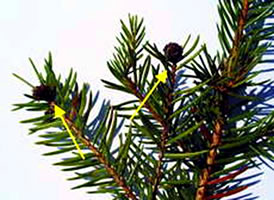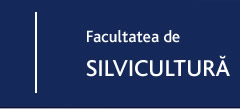|
Phase A: Establishing the efficacy of some commercial bio pesticides, which it has not yet introduced in IPM of some agricultural and sylvic pests.
Development and objectives:
The role of constitutive metabolites in plants fighting against biotic factors, the role of volatile components in priming plant to herbivores attacks. Analysing of molecular mechanisms which take place in induced resistance against biotic factors and increasing plant productivity by treatments with BIONR, OxyxomTM, MessengerR or extracted by Reynoutria sachaliensis- Milsana R și BTH.
Researches projects:
Grant CNCSIS nr. 768 /2007-2008. Implementation of some biorational pesticides in integrated pest management (IPM) for keeping the ecosystems biodiversity.
Research team: Valentin BRUDEA, Marian-Ioan RÎȘCA, Cezar Valentin TOMESCU.
e-mail vbrudea@yahoo.com
The researches are focused on pine large weevil Hylobius abietis the main pest of the resinous seedlings installed shortly after wood exploitation. After two years researches the bio pesticide spinosad (Laser 240 SC) was very efficacy in the pine large weevil control by foliar seedling application or on the toxic bark. The bio pesticide may be an alternative to replace use of pyretroid insecticides, which affect the entomophagous insects. We can conclude that the spinosad (Laser 240 SC) protected the resinous saplings from the pine weevil Hylobius abietis, attack by leaf applied or on toxic bark treatments. The biopesticide did not influence negatively the entomophagus predators .
 |
 |
Hylobius abietis adults mortality on the toxic barks
treated with Laser 240 SC. |
|
 |
 |
Toxic barks treated with Laser 240 SC and
alive ants |
Toxic barks treated with Sinoratox 5 G, with dead
pine weevil, but also carbides predators, too |
In the management of the larch wooly adelgid Adelges laricis, in the lab tests, the microbial products Laser 240 SC and Milbeknock and the vegetal one NeemAzal T/S, had a high efficacy against the young larvae of Adelges laricis (98-100%) and more reduced against the older larvae (60-98%). In the experiments on trees all bio pesticides had high efficacies.
Attack produced by Adelges laricis on the larch needles and galls on spruce (original).
 |
 |
| Attack produced by larvae on larch macro blasts |
Galls produces by fundatrix females on spruce |
 |
 |
| Larva |
Eggs laid by the aptere female |
In the management of the chestnut tree leaf miner Cameraria ohridella the use of Laser 240 SC and NeemAzal T/S by spraying, the leaves attack was between 20-30%, comparatively with 80% for the untreated witness. The treatments by painting with NeemAzal T/S reduce the mining larvae number and also the attack's degree on the leaves. After 35 days from the treatment its take place a rising of the attack due to the pressure of the next generation therefore another treatment is necessary.
In the control of Colorado potato beetle (Leptinotarsa decemlineata Say) the biological insecticides Laser 240 SC presents a high efficacy, for all larvae instars, after three days after applications, in both doses of 0.1 and 0.08 l / ha.
In the lab, NeemAzal T/S in doses of 2.5 and 2 l / ha presents efficacy against the very young larvae and less against the adults. In the field, the same doses presents a higher efficacy for a concentration of 600 l water / ha. Mortality is higher for the young larvae than the old ones and the treatment must be preventive.
 |
 |
| Mortalities of larvae of Colorado potato beetle after treatment with NeemAzal T-S 3 l/ha in 600 l water. |
The dead larvae on the soil |
Phases: Obtaining metabolites from spontaneous plants and testing effects on phytophagous insects.
Our researches, at the beginning, are canalised to put in evidence presence of phytochemicals in our indigenous plants do posses insecticidal proprieties, feeding deterrents, growth inhibitors and repellents, without to affect insects' predators. The studies starting with metabolite extracts from 15 plants tested against the mealy plum aphid (Hyalopterus pruni Geoffroi - Ord. Homoptera).
 |
 |
| The mealy plum aphid (Hyalopterus pruni Geoffroi) |
The mortality of Hyalopterus pruni at one day after
the treatment with wormwort (absynth)
(Arthemisia absinthium) extract. |
 |
 |
The mortality of Hyalopterus pruni on one day
after
the treatment with danewort
(Sambucus ebulus) extract |
The mortality of Hyalopterus pruni after the treatment
with speedwell (Tanacetum vulgare) and
wormwort (Arthemisia absinthium) extracts |
 |
 |
| TThe mortality of Hyalopterus pruni after the treatment with speeedwell (Tanacetum vulgare), danewort (Sambucus ebulus) and wormwort (Arthemisia absinthium) extracts. |
The itonidid predator Aphidoletes aphidiomyza Rond, unaffected by extracts. |
In the control of Colorado potato beetle the aqueous extracts from plants, applied against the Colorado beetle induced high levels of mortality at the treatments with Athirium filix-femina, Aristolochia clematidis, Urtica dioica and Arthemisia absinthium. The combinations of Tanacetum vulgare with Arthemisia abinthium and Tanacetum vulgare with Sambucus nigra presented the greatest mortalities.
High efficacies were observed against the larvae of first ages. Some extracts induced phytotoxic phenomena like the turning to yellow of the leaves. In order to avoid the fermentation of the extracts it is recommended to use organic solvents for extraction that permits a better long-time preservation.
Publications
Brudea V., Ciuclă C., Țurcanu R., 2006 - Cercetări privind introducerea produsului biologic spinosad în managementul integrat de combatere a unor insecte forestiere (IPM). Referat susținut la al 49-a Conferință Științifică internațională a Fac. de Agronomie Iași, p. 559-564, ISSN 1454-7414.
Brudea V., 2006 - Implementarea managementului integrat al dăunătorilor (IPM) în ecosisteme, sistemul educațional și comunități. Referat susținut la al 49-a Conferință Științifică internațională a Fac. de Agronomie Iași, p. 565-572, ISSN 1454-7414.
Tomescu Cezar, Brudea V., Rîșca M., 2007 - Cercetări preliminare privind eficacitatea unor metaboliți vegetali în combaterea păduchelui cenușiu al prunului Hyalopterus pruni Geoffroi - O. Coleoptera. Lucrare susținută la Simpozionul Fac. Silvicultură Suceava, oct. 2005, Anale Fac. Silvicultură Suceava (sub tipar).
Brudea V., Enea C., Rîșca I.-M., Tomescu C.V., 2008 - Efficacy of some biological insecticides in the control of potato beetle Colorado (Coleoptera - Leptinotarsa decemlineata Say). Referat susținut la a 51-a Conferință științifică internațională, Iași, Fac. de Agricultură,Univ. Șt. Agr., Fac. de Agricultură, Lucr. Șt., nr. 51, p. 275-280.
Brudea V., Rîșca I.-M., Enea C., Tomescu C.V., 2008 - Efficacy of some biological insecticides in the control of potato bettle Colorado (Coleoptera - Leptinotarsa decemlineata Say). Referat susținut la a 51-a Conferință științifică internațională, Iași, Fac. de Agricultură, Lucr. Șt., nr. 51, p. 280-286.
Brudea V., 2009 - The efficacy of some biopesticides and vegetal metabolites in the control of spirea aphid Aphis spiraephaga Müller (O. Homoptera - F. Aphididae), Facultatea de Agronomie, 52-a Conferință științifică internațională, Iași din 22-23 oct. 2009.
Brudea V., Rîșca I.-M., Tomescu C.V., Daniela Lupaștean, Fărtăiș L., 2008 - Metaboliți vegetali cu utilizare în managementul integrat al insectelor. Editura univ. "Ștefan cel Mare" Suceava, p. 316.
Brudea V., 2009 - Implementation of some biopesticides in the integrated pest management of large pine weevil Hylobius abietis L (Coleoptera - Curculionidae). Fac. Agronomie, a 52-a Conferință științifică internațională, Iași 22-23 oct. 2009).
Brudea V., Rîșca I.-M., 2010 - Implementation of some biopesticides in integrated pest management of larch aphis Adelges laricis Vallot (F. Adelgidae - Homoptera) and the horse chesnut leaf miner Cameraria ohridella Desh and Dimic (F. Gracillariidae - Lepidoptera) (lucrarea susținută la Simpozionul internațional al Fac. Silvicultură, 18 septembrie, 2009, in press, Cercetări Agronomice in Moldova, trim. IV, 2010).
Phase B : The role of the main volatile substances characteristic for Norway spruce in the answer of bark beetles Ips typographus and Ips duplicatus to their aggregative pheromones.
Research team: Leonard DUDUMAN, Valentin BRUDEA, Anca MĂCIUCĂ, Cătălina BARBU
Testing the response of Ips typographus adults to various combinations of alpha-pinene, limonene and synthetic aggregation pheromone (O1) requires the realization of experiments in the field which will consist of testing the attractiveness l of various combinations of monoterpenes and synthetic pheromone of Ips typographus adult beetles in the conditions when the synthetic pheromone is released with the constant rate and the combination of monoterpenes with variable rate. In this context, there are at least three experiments to be conducted, individually by the release rate of the pheromone dispenser. In each experiment there will be tested at least five different experimental variants, separated by the release rate of the combinations of monoterpenes (alpha-pinene and limonene), the pheromone release rate being constant. Each experiment will be repeated in at least two areas. Each set of variants (which make up an experimental block) will be repeated at least six times in experimental areas. The dispensers with pheromones and monoterpenes will be installed in traps aircraft wing type. The collection of the biological material from the traps will be made at an interval of 3-4 days. At each harvest the dispensers will be moved one step from one trap to another, so that each version goes at least once by each trap position in a block experiment. Making this, it is strongly reduced the influence of the trap position on the response of the Ips typographus beetles.
Achieving this goal requires also laboratory analysis. They consist in the production and testing required dispensers, both the pheromone and those with monoterpenes. After their production, all dispensers will be tested in controlled climate conditions (climate chamber) at constant temperature and humidity (T = 20 ° C, RH = 50%).
Evaluating the volatile natural characteristic of the spruce on Ips duplicatus adults response to commercial pheromone attractants (O2) will be made by field testing of the beetle Ips duplicatus response to the synthetic pheromone traps installed in the wing that is mounted in the prosecution of different seniority, in the concentration of volatile substances characteristic natural spruce varies with the age of the stump and of the existing wood material. The experiment will be installed in at least four surfaces (two fresh and two operated at least one year earlier). In each area there will be installed six-wing traps, baited with specific synthetic attractive for Ips duplicatus. The captured material will be harvested every week.
Testing the response of Ips duplicatus adults to various combinations of aggregative synthetic pheromone with monoterpene alpha-pinene, limonene and myrcene. (O3). Experiments carried out under this objective also consider the analysis of the response o the Ips duplicatus beetles, but this time using next to synthetic pheromone the volatile substances characteristic for spruce also synthetically produced (alpha-pinene, limonene, myrcen). There will be developed at least three experiments in the field. For all experiments there will be used dispensers with synthetic pheromone release fixed rate (same rate across all experiments). Experiments will differentiate by the combinations of monoterpenes used and the rates of their release. A first experiment will test, for example, the Ips typographus adults' response to the combination of synthetic pheromone and (-)-alpha-pinene, when the release rate of monoterpenes varies.
 |
 |
Intercept trap |
Climatic chamber with dispenser testing |
In each experiment there will be tested at least five different experiments, each variant being characterized by a specific release rate of monotetpene or combinations of monoterpenes. Variants tested will also be installed in the wing-type traps.
Each experiment will be carried out in at least two areas, similar in terms of station.
Researches projects:Grant CNCSIS PD_563/2010
director of project dr. ing. Duduman Mihai Leonard
 Experimental field block for bark beetles response with different olfactory stimulus Experimental field block for bark beetles response with different olfactory stimulus
.
|



















